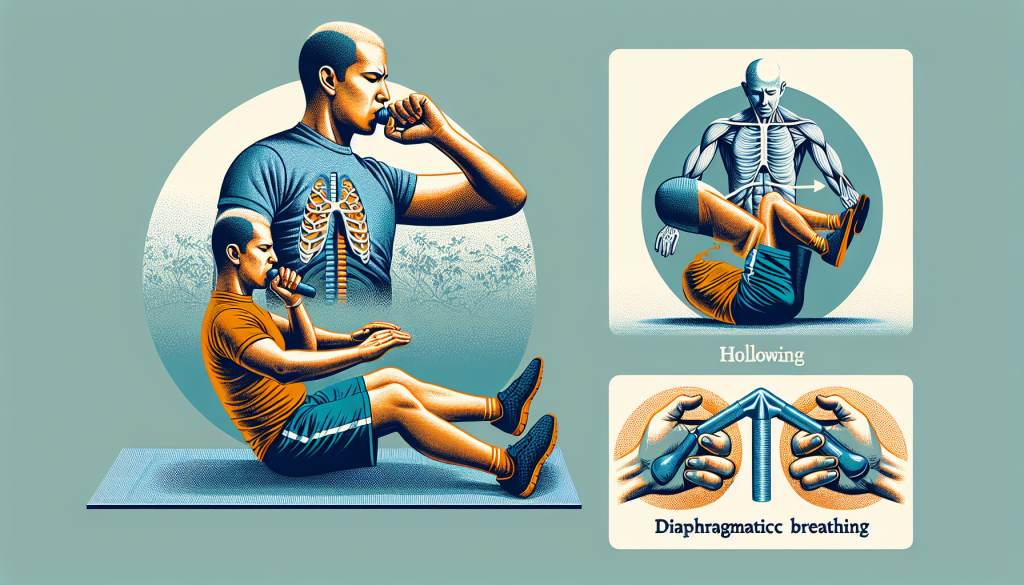You’ve probably heard about the importance of breathing during workouts, but did you know that it can actually enhance your ab exercises? Many people wonder if there are any specific breathing techniques that can aid in building six-pack abs and strengthening core muscles. In this article, we will explore the connection between breathing and ab workouts, providing you with valuable insights and tips to optimize your training routine. So, let’s take a deep breath and dive into the world of abdominal exercises and effective breathing techniques!
Breathing techniques for ab workouts
When it comes to ab workouts, proper breathing techniques can make a world of difference. Not only can they help engage and activate your core muscles, but they can also enhance stability and support during challenging exercises. In this comprehensive article, we will explore the importance of proper breathing during ab workouts and discuss various breathing techniques that you can incorporate into your routine. So, let’s dive in and discover the power of breathing for a strong and sculpted core!
The importance of proper breathing during ab workouts
Before we delve into the breathing techniques themselves, let’s first understand why it is essential to pay attention to your breath during ab workouts. Breathing plays a crucial role in core activation, which is essential for proper form and optimal results.
Understanding the role of breathing in core activation
Your core muscles, including the rectus abdominis, obliques, and transverse abdominis, work together to provide stability and support for your spine. When you breathe deeply and engage your diaphragm, you activate and strengthen these deep core muscles. This not only helps you maintain better posture but also enhances overall core strength and stability.
Benefits of proper breathing during ab workouts
Proper breathing during ab workouts offers numerous benefits. Firstly, it helps you maintain better control and coordination of your movements, allowing you to perform exercises with greater precision and effectiveness. Secondly, it helps prevent unnecessary strain on your neck, shoulders, and lower back by ensuring that your core muscles are doing the majority of the work. Lastly, proper breathing during ab workouts can help enhance focus and concentration, allowing you to get the most out of your training session.

Breathing techniques to engage the core muscles
Now that we understand the importance of proper breathing, let’s explore some effective techniques to engage your core muscles during ab workouts.
Diaphragmatic breathing
One of the most fundamental breathing techniques for core engagement is diaphragmatic breathing. This technique involves breathing deeply into your belly, allowing your diaphragm to fully expand. To practice diaphragmatic breathing, place one hand on your chest and the other on your belly. Take a slow breath in through your nose, allowing your belly to rise as you fill your lungs with air. Exhale slowly through your mouth, emptying your lungs completely as your belly falls. By focusing on deep belly breaths, you encourage proper activation of your core muscles.
Exhale on exertion
Another effective breathing technique is to exhale on exertion. This means that you exhale as you perform the most challenging part of an exercise. For example, if you are doing crunches, you would exhale as you lift your upper body off the ground. This technique not only helps engage your core muscles but also assists in expelling air and promotes better control of your movements.
Hollowing technique
The hollowing technique is a breathing technique aimed at activating the transverse abdominis, the deepest layer of the abdominal muscles. To practice this technique, start by lying on your back with your knees bent and feet flat on the floor. Take a deep breath in, and as you exhale, draw your belly button in towards your spine, creating a hollowing sensation in your abdomen. Hold this contraction for a few seconds, then release and repeat. The hollowing technique helps strengthen the deep core muscles and can be particularly beneficial for individuals with postural imbalances or lower back issues.
Breathing techniques to enhance abdominal stability
In addition to engaging the core muscles, proper breathing can also enhance abdominal stability during ab workouts. Here are two effective breathing techniques to incorporate into your routine.
Drawing the navel towards the spine
Drawing the navel towards the spine is a simple yet powerful technique to enhance abdominal stability. To practice this breathing technique, start in a seated or standing position with good posture. Take a deep breath in, and as you exhale, draw your navel towards your spine, engaging your deep core muscles. Hold this engagement as you continue to breathe, focusing on maintaining stability and control throughout your ab exercises. This technique helps activate the transverse abdominis, providing a stable foundation for your movements.
Bracing the core
Bracing your core involves contracting all the abdominal muscles to create a strong and stable core. To practice this technique, start by standing or sitting tall. Take a deep breath in, and as you exhale, squeeze your abs as if you were preparing to get punched in the stomach. Imagine creating a protective shield around your midsection. Maintain this bracing sensation as you perform your ab exercises, keeping your core muscles engaged and supporting your spine.

Breathing techniques for challenging ab exercises
As you progress in your ab workouts, you may encounter more challenging exercises that require additional support from your breath. Here are a few breathing techniques to help you conquer those advanced moves.
Pursed lip breathing
Pursed lip breathing is a technique that can help you maintain control and stability during challenging ab exercises. To practice this technique, inhale deeply through your nose, then purse your lips slightly and exhale slowly through your mouth. The act of exhaling through pursed lips helps regulate the flow of air, allowing you to control your breath and movements more effectively.
Segmental breathing
Segmental breathing involves consciously directing your breath to different parts of your abdomen. This technique can be particularly beneficial for exercises that involve twisting or lateral movements. Start by inhaling deeply and focusing your breath on one side of your abdomen. As you exhale, move your breath to the other side, emptying your lungs completely. Continue to alternate the focus of your breath with each repetition, promoting greater stability and balance throughout the movement.
Three-part breath
The three-part breath technique is a powerful tool for engaging your entire core and maximizing breath control during challenging ab exercises. Begin by inhaling deeply, filling your lower belly, then expanding your ribcage, and finally lifting your chest. As you exhale, reverse the process, releasing the air from your chest, ribs, and lower belly. This technique helps activate all the layers of your core muscles and encourages a more efficient exchange of oxygen and carbon dioxide.
Pilates breathing
Pilates breathing is a technique commonly used in Pilates exercises, which are known for their emphasis on core strength and stability. To practice Pilates breathing, inhale deeply through your nose, expanding your ribcage, and allowing your lower belly to rise. As you exhale, draw your belly button in towards your spine, engaging your deep abdominal muscles. This technique promotes proper core activation and can enhance overall control and precision during challenging ab exercises.
Common mistakes in breathing during ab workouts
While understanding the correct breathing techniques is essential, it’s equally important to be aware of common breathing mistakes that can hinder your progress and potentially lead to injury. Avoid these common pitfalls during your ab workouts:
Holding the breath
One common mistake is holding your breath during ab exercises. While it may initially feel instinctive to hold your breath, this can limit oxygen intake, disrupt core engagement, and increase tension in your neck and shoulders. Remember to focus on maintaining a steady and controlled breath throughout your entire workout.
Shallow or chest breathing
Shallow or chest breathing, characterized by quick and shallow inhalations and exhalations, can restrict the effectiveness of your ab workouts. Aim for deep belly breaths to fully engage your diaphragm and properly activate your core muscles. This not only ensures optimal oxygen intake but also promotes greater stability and control.
Inconsistent breathing pattern
Developing a consistent breathing pattern is vital for maintaining rhythm and control during ab exercises. Avoid erratic or irregular breathing, and instead, strive for a steady and coordinated breath that supports your movements. This consistency in your breathing pattern will help you find your flow and perform exercises with greater ease.

Tips for incorporating proper breathing into ab workouts
Incorporating proper breathing techniques into your ab workouts may require some practice and conscious effort. Here are a few tips to help you master the art of breathing during your core training:
Practice breathing separately
To develop better control over your breath, set aside some time to practice breathing exercises separate from your ab workouts. Lie down or sit in a comfortable position and focus solely on deepening your breath, engaging your core, and mastering the various breathing techniques. Regular practice will eventually make it more intuitive to apply these techniques during your actual workouts.
Start with low-intensity exercises
If you’re new to incorporating proper breathing techniques into your ab workouts, it’s best to start with low-intensity exercises. Perform exercises that allow you to focus on your breath without overwhelming you with intensity. As you become more comfortable with the breathing techniques, gradually incorporate them into more challenging movements.
Consciously focus on breathing
During your ab workouts, make a conscious effort to focus on your breath. Stay present and attentive to your inhales and exhales, checking in with the activation of your core muscles. By directing your attention to your breath, you’ll naturally develop a greater mind-body connection, leading to more effective and efficient workouts.
Use verbal cues or visual aids
If you find it challenging to remember to breathe properly during your ab workouts, consider using verbal cues or visual aids as reminders. You can repeat phrases like “inhale, exhale” or place stickers or notes in your workout space to draw your attention to the importance of breathing. Over time, these cues will become ingrained in your routine, allowing for seamless integration of proper breathing techniques.
Breathing techniques for specific ab exercises
Different ab exercises may benefit from specific breathing techniques. Let’s explore how you can incorporate proper breath control into some common ab exercises:
Crunches
During crunches, exhale as you lift your upper body off the ground, contracting your abs. Inhale as you lower your upper body back down, preparing for the next repetition. This coordinated breathing pattern supports core engagement throughout the movement.
Planks
When performing planks, aim for a steady and controlled breath. Inhale deeply, engaging your core as you hold the plank position, and exhale as you release the position. Focus on maintaining your breath and core activation for the duration of your plank.
Russian twists
For Russian twists, synchronize your breath with each twist. Inhale as you center your torso, and exhale as you twist to each side. This breathing pattern enhances stability and control as you rotate.
Leg raises
During leg raises, exhale as you lift your legs off the ground, engaging your lower abs. Inhale as you lower your legs back down, preparing for the next repetition. This coordinated breathing ensures proper activation of your core throughout the exercise.

Expert advice on breathing techniques for ab workouts
While proper breathing techniques are generally beneficial for most individuals, it’s essential to remember that everyone’s body is different. To ensure that you are incorporating the most suitable breathing techniques for your needs, it’s valuable to consult a fitness professional. A qualified trainer or physical therapist can assess your unique requirements and tailor breathing techniques that best support your core training. By working with an expert, you can maximize the benefits of proper breathing and achieve optimal results while minimizing the risk of injury.
Conclusion
Breathing techniques may not be the first thing that comes to mind when you think about ab workouts, but their importance cannot be overstated. By practicing proper breathing techniques, you can engage and activate your core muscles, enhance stability, and support during challenging exercises, and maximize the effectiveness of your ab workouts. Whether you are a beginner or an advanced fitness enthusiast, incorporating these breathing techniques into your routine will set you on the path to a stronger, more stable, and sculpted core. So remember, the next time you hit the mat for your ab workout, take a deep breath and let your breath be your guide towards a stronger, fitter you.





